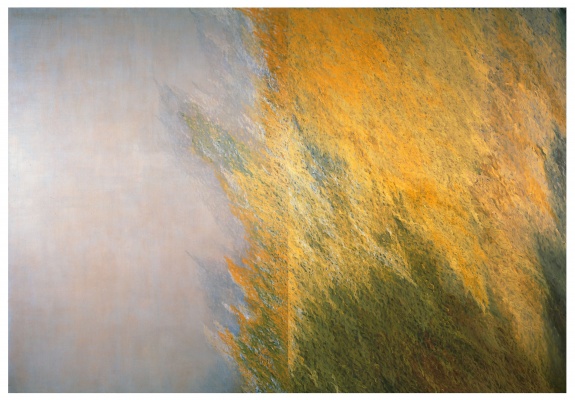Descripción de la Exposición
In Fantasía herida, Fátima Rodrigo (Lima, 1987) explores the frictions present in the construction of our imaginary and affectivity, through the exploration and extrapolation of elements from popular culture, the entertainment, fashion and design industries. The story in which Fatima immerses us is neither linear nor unidirectional. In it, a visuality loaded with fantasies and desires is shown as a space in constant dispute, where exploitation, discrimination, exclusion and invisibilization of the past, inescapable to the ideals of progress and western modernization, reappear under new forms and configurations. Fatima’s work then dwells on marginal details of the images she examines, as if they were small wounds, which allow her to make out certain power dynamics that still persist in the production of images in Latin America.
*
During the second half of the 20th century, ballads and salsa romántica, with their strident sentimentalism, permeated the radios and musical programs of Latin American television, leaving deep traces in the conception of romantic love. Along with these melodies about love and heartbreak, as one of the songs Solo el silencio responde (Only silence answers) says, and in parallel to what was happening on the other side of the screen -revolutions, guerrilla movements, land and factory seizures-, many geometric and abstract forms charged with illusions of modernity and order impregnated the scenarios of these television programs and the costumes of the performers. Fatima dwells on these figures and their historical, ideological and political connotations. On the one hand, the very origins of these forms contain a certain erasure. In the official narrative on abstract art, it still appears as an anecdotal fact how this trend, born in Europe but widely spread in the United States, appropriated certain pre-Columbian iconography and traditional Andean weaving techniques. On the other hand, it is well known how the promotion of this non-figurative art in the region was related to anti-communist policies during the Cold War.
In Telón II and in a series of textile pieces, Fátima captures these modernist patterns from the scenographies and costumes of the singers. She reworks them manually, using beads, sequins, frost and scraps of industrial fabrics - materials close to the domestic and festive atmosphere - and transfers them to new supports. The origins of these forms begin to blur until new abstract forms emerge, similar to their modernist referents. This gives rise to a series of questions about how deeply this aesthetic permeated the visuality of the region (in what other spaces of our everyday life did these forms filter through?), and about its implications in the production and reproduction of a discourse and imaginary of modernity where the West imposes itself as a paradigm while other local aesthetics are assimilated as minor. In Fatima’s work, then, an intentional dissonance emerges in which abstract forms, precarious materials and techniques learned in Youtube tutorials are intertwined, and seems to represent a movement of material and symbolic borrowings always present -but rarely visible- between tradition, popular culture and art. All this ends up delineating a complex imaginary that articulates our identity as a region.
*
A similar exercise occurs with Ojos que no ven, Dicen que soy and Ejercicios de resistencia, this time based on images that are in circulation today. In a previous set of works, Fatima started from well-known fashion photographs, where models with Western features posed wearing garments inspired by traditional costumes. With some difficulty, it was possible to distinguish how these scenes took place in patron saint festivals, since in the background, certain elements -such as masks and snakes- belonging to the costumes of Andean women and men could be glimpsed. Fatima’s gaze lingered on these details as if they were cracks that allowed her to approach certain historical omissions -not at all innocent- of the high fashion and design industries.
In this new group of pieces, Fatima collects images of snakes and eyes that evoke folkloric masks. These figures circulate through differentiated spaces due to their symbolic and economic value - combi stickers, tattoos, Instagram posts, high fashion and design objects - and then reinterpret them in bronze, beads and on work gloves. Finally, he introduces them to the artistic field, where their origins and distances are erased. Through this mechanism of decontextualization, manipulation, homogenization and insertion into a new space, Fatima reflects on how similar images, but produced from different genders, social classes, contexts and geographies, acquire particular hierarchies. Their possibility of being visible and desired depends on that ordering. Thus, these works also question the place of enunciation and privilege that art has had and still has.
*
Like a dropped disco ball that paralyzes a party night, Fatima’s work wounds and interrupts a widespread fantasy in which visuality is conceived as an innocuous space, and where certain logics of our colonial past, still present under the ongoing process of capitalist modernization, are perceived as overcome. These works point in the opposite direction to evidence these fissures and tensions through new visual explorations that, instead of erasing the conflicts that lie behind the images, expose them and invite us to problematize them. Like a reassembled T-shirt that exposes its seams.
Emilia Curatola Fernández

Premio. 25 mar de 2025 - 08 may de 2025 / Madrid, España

Exposición. 10 abr de 2025 - 12 oct de 2025 / Institut Valencià d’Art Modern (IVAM) / Valencia, España

Formación. 08 may de 2025 - 17 may de 2025 / Museo Nacional Centro de Arte Reina Sofía (MNCARS) / Madrid, España